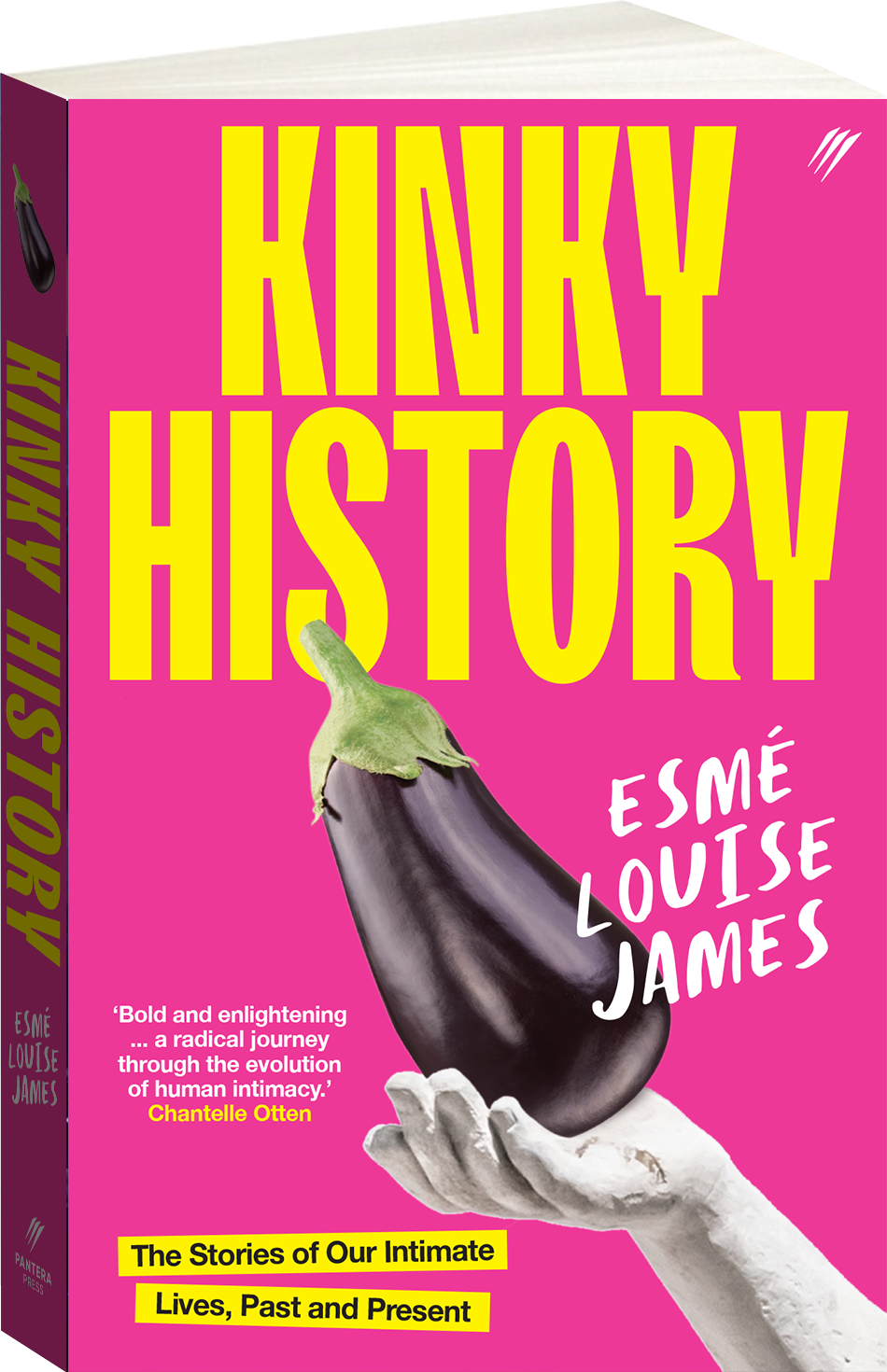Kinky History draws on ESME LOUISE JAMES’s phenomenally successful series on TikTok, which explores scandalous stories in the ancient world and the saucy secrets of famous figures.
Teaming up with her statistician mother, Dr Susan James, the pair have surveyed the nation for all of your intimate secrets – and the results are in.
By placing the past in conversation with the present, she explores five ‘kinks’ that challenge our thinking about sex.
Kinky History aims to blow open our conversation about sexuality and gender.
Get ready … In this extract we take on Sense and Syphilis.
Hippocrates (460–375 BCE) – considered by many as the Father of Medicine – had some truly remarkable ideas regarding how to prevent pregnancy. In his work On the Seed, he suggests that a woman who ‘had the habit of going with the men’ should ‘jump up and down, touching her buttocks with her heels at each leap’ to evacuate semen following intercourse.
If you weren’t much in favour of exercise, Hippocratic writers also had a suitable solution. Believing obesity would cause infertility, weight gain was also highly recommended in order to prevent any unwanted pregnancies.

And during the sexual act, at the critical moment of coitus when the man is about to discharge the seed, the woman must hold her breath and draw herself away a little, so that the seed may not be hurled too deep into the cavity of the uterus. And getting up immediately and squatting down, she should induce sneezing and carefully wipe the vagina all round; she might even drink something cold.
Some methods bore a little more credibility. Aristotle, for instance, recommended covering the vagina with cedar oil – a method which finds its roots in Ancient Egypt. Contraceptive methods are listed in what remains of the Kahun Gynaecological Papyrus (1850 BCE) – the oldest medical text in Egypt and the second oldest text in the entire world – as well as the Ebers Papyrus (1550 BCE). Such methods include inserting a mixture of dates, honey and gum from acacia leaves into the vagina.
A strange method, but one that was likely somewhat successful. When the gum from these leaves is compounded, it essentially becomes spermicide, and is still used in many contraceptive jellies today.
Other methods were not quite so impressive: for example, inserting a small, soluble block of crocodile faeces (mixed with honey) before getting down and nasty. This aromatic concoction was inserted like a tampon, allowing the crocodile poo to act as an absorbent sponge for any semen. It was also a technique guaranteed to make a lover say, ‘See you later, alligator,’ which I suppose makes it an effective contraceptive after all.
Ancient Egyptians may have used early versions of the condom – linen sheaths wrapped around their ‘little pharaohs’ – though these were intended to prevent disease far more than pregnancy. Even 3,000 years ago we were aware that disease could be spread through sexual intercourse. At the time, Egyptians were most concerned about the spread of bilharzia, an infection caused by parasitic worms, which could (and does) lead to chronic health issues.
These linen sheaths are mere conjecture, though: there is some debate regarding whether ‘penis protectors’ can be traced back to ancient times at all, as pregnancy was most often considered the woman’s responsibility, and thus most recorded methods tend to revolve around female contraception. The only male contraceptives recorded reliably are coitus interruptus and coitus per anum – fancy ways of saying pulling out and butt stuff.
Contraceptives experience a decline in popularity with the fall of the Roman Empire. The 5th century rolls around and St Augustine is there ready to condemn them, while playing absentee father to his out-of-wedlock child. As contraception became stigmatised, awareness of these established methods dwindled.
However, the demand (and desire) to prevent pregnancy clearly did not – leading us to turn to increasingly bizarre methods.Weasels, for whatever reason, appeared to take on a starring role in Medieval Europe. In France, it was believed that ‘if the foot of a female weasel was cut off leaving the animal still alive and the foot dried and hung as a pendant about her neck, the woman would not conceive. If she took it off she would become pregnant immediately.’
It wasn’t just female weasels that got the rough end of the bargain. Toronto’s History of Contraception Museum also makes mention of the use of male weasels: ‘If one takes the two testicles of a weasel and wraps them up, binding them to the thigh of a woman who wears also a weasel bone on her person, she will no longer conceive …’ With your handy testicles in hand, ‘pop’doesn’t go the weasel.
It really takes until the 16th century for contraception to regain substantial documentation. This can largely be attributed to the syphilis epidemic, which spread through Europe and Asia at the same time. This disease did not look like it does today. When it first arrived on the scene, syphilis was far more deadly.
As historian Jared Diamond has summarised, ‘when syphilis was first definitely recorded in Europe in 1495, its pustules often covered the body from the head to the knees, caused flesh to fall from people’s faces, and led to death within a few months’.
Gabriele Falloppio’s The French Disease (1564) describes the use of linen sheaths that were soaked in a chemical solution before being tied around the penis with a ribbon, like a beautiful little present.
It is consequently no wonder that, after syphilis arrived in Asia in 1505, recorded uses of condoms simultaneously appear. Kabuto-gata, a ‘helmet’ which sits on top of the penis, is recorded in Japan around this time. It was first made of tortoise shell or horn, though such materials would later be replaced by a thin leather (this was called the mara- bukuro, with the very amusing translation of ‘penis-sack’).
The first uncontested account of condom use appears in the 16th century, for the purpose of disease prevention rather than contraception. Avoiding pregnancy seems to have been an unexpected bonus for the invention of the condom, rather than its main aim.
Gabriele Falloppio’s The French Disease (1564) describes the use of linen sheaths that were soaked in a chemical solution before being tied around the penis with a ribbon, like a beautiful little present. Falloppio claimed his invention withstood the trials of scientific experimentation, having tested the preventative device on 1,100 different men, none of whom contracted syphilis (though all of whom, I imagine, were more than happy to participate in the experiment).
This wasn’t the only widespread syphilis epidemic to shake the world. The disease was to again rear its head in the 19th century – a fact unlikely to be covered in many Jane Austen adaptations. Regardless, it is an unacknowledged truth that one in five Londoners would have had syphilis by the age of 35.
Dearest Readers
… this author will not deny you that which you most desire – the Truth! I must here warn those of a genteel heart and womanly sensitivity to LOOK AWAY! Return to your piano or take a turn around the garden. Do not allow your nerves and mind to be disturbed by the salacious secrets of London’s immoral crowd.
***
If that number isn’t already shocking enough, historians also estimate that the number of Londoners who contracted gonorrhoea or chlamydia was far higher. As historian Simon Szreter stated:
The city had an astonishingly high incidence of STIs at that time. It no longer seems unreasonable to suggest that a majority of those living in London while young adults in this period contracted an STI at some point in their lives.
Not only was sex already steeped in ideas of sin and shame, now the prevalence of sexually transmitted infections reinforced dominant cultural ideas about sex as dirty: a source of contagion that needed to be controlled.
There was no effective cure found for syphilis (or ‘the pox’) until the beginning of the 20th century, meaning that if you happened to fall within the unlucky 20 per cent, there was generally no hope of recovery. Brothels and other forms of sex work were prolific across England during this time, infamously referred to as ‘the great social evil’. As may well be expected, the spread of syphilis and the popularity of these establishments were not entirely unconnected.
Admission records of London’s hospitals and workhouse infirmaries show that the disease was particularly rife among young, impoverished, mostly unmarried women, who used commercial sex to support themselves. With no effective treatment available for the pox, those afflicted were often prescribed mercury as a treatment (which, thanks to the privileges of science, we know to be just as detrimental as untreated syphilis – if not more so). This led to the popular saying: ‘A night with Venus, and a lifetime with mercury.’
It wasn’t only a cure for STIs that was lacking but also preventative methods. While condoms did exist, they were not anywhere near as widely accessible, encouraged or effective as they are in many countries today. One of the major proprietors of condoms within Regency London (particularly for sex workers) was Mrs Phillips, who held a shop in Covent Garden.
These ‘condoms designed for gentlemen’ were (I encourage you to hold your stomach) made ‘of sheep’s or goat’s gut, pickled, scented, eight inches long, delicately fashioned on glass moulds by the hands of the proprietress’. While certainly better than nothing, the material of which these condoms were made meant they were prone to breaking (and certainly not the sexiest addition to one’s licentious affairs).
Condoms made of these ingredients had become quite widely available during 18th century, sold from pubs and chemists, theatres and market shops. However, these were only readily available to the middle and upper classes. What made Mrs Phillips notable is that she primarily catered to female sex workers, servicing the market for which no one else was accounting. She dedicated herself to creating ‘implements of safety’ for all customers who cared to frequent her shop, advertising her wares as such:
To guard yourself from shame or fear
Votaries to Venus, hasten here
None in our wares er’er found a flaw
Self-preservation’s Nature’s law.
It would not be until the 1910s that the first effective treatment for syphilis was developed: the drug Salvarsan. By the 1940s, a safe and accessible cure was established with the production of penicillin – one of the inventions in that decade that would truly change our sex lives forever.
ABOUT THE AUTHOR

On social media she has developed her wildly popular Kinky History video series, which explores the history of human sexuality across a range of platforms (including TikTok, Instagram and YouTube). Her series, SexTistics, uses statistics to create a snapshot – past and present – of gender, sexuality and identity in Australia.
Esmé was a speaker at TEDxSydney in 2022, and her writing has been published in the Age, the ABC, The Conversation and the Herald Sun. In 2020, she was listed in the Top 30 Emerging Writers by SBS Australia. Esmé’s career goals include continuing to build her platform as an academic communicator using various forms of popular media to reach and educate a mainstream audience.






